NEWS
Un millón de años de evolución cultural en Atapuerca, California Southern University (Costa Mesa, California, USA) (26th March 2021)

Palaeolithic and Quaternary Seminars Series, University of Oxford (Oxford, UK) (12th March 2020)

"The Western European Acheulean: reading variability at a regional scale"
The Acheulean technology meant a revolution and its presence can be clearly tracked out of Africa from Asia to Europe. Nevertheless, the different criteria used for analysing and categorising the results make it difficult to compare data from different research traditions. So, the definition of a common method of analysis for the study of Large Cutting Tools is crucial to read the Acheulean from a regional perspective. I have explored the Middle Pleistocene human presence in the European Atlantic seaboard, studying several Acheulean key sites, from the Iberian Peninsula to France and Britain, and from 700ka to 300ka, and using a unified system: the WEAP Method. This is based on the selection of several technological attributes from the main traditions of lithic analysis, considered to be especially significant. In addition, this analysis is complemented by a deep exploration of the tool's shape, applying geometric morphometrics on 3D models. The combination of all these analyses clearly demonstrates the existence of several technological Acheulean scenarios in Western Europe and leads us to understand this area as an ecological unit where Middle Pleistocene hominins lived and moved, leaving tracks of their movements.
Conference - "Humans in Transition: The occupation of Western Europe, 500-400ka" (British Museum, London, UK) (18th October 2019)
Conference summary:
Recent research has identified a critical threshold in human behaviour in Europe from c. 500,000 to 400,000 years ago. From this period there is an explosion in the number of sites and the quantity of artefacts on those sites; there is more persistent use of caves; new technologies appear, including, widespread use of handaxes, the first clear evidence of hunting and good evidence for the use of fire. Different human fossils have been interpreted as either Homo heidelbergensis or early Neanderthals, or those with a mix of morphologies, but one common trait is that brain size had approached modern levels. These developments took place in the context of climatic and environmental change.



The Western European Acheulean Project (WEAP, Marie Skłodowska Curie F-EF-ST, n. 748316) has examined the differences and similarities in lithic technology from south to north within this region between 700,000 to 300,000 years ago, through the study of 10 Middle Pleistocene contexts, some of them with two different chronological horizons: Brandon Fields, Boxgrove, Swanscome-UMG and Elveden (UK); La Noira, Cagny la Garenne, Menez Dregan and St Pierre les Elbeuf (France); Galeria and TD10.1 level of Gran Dolina, (Atapuerca, Spain). Its aim has been to develop a common methodology to describe the different lithic signatures and to understand them in the context of changing climate and the consequent movement in human population. The one-day conference will focus on how to understand the impact of the changing environments, the latest interpretations of the hominin record and the full results of the comparisons between selected lithic assemblages from western Europe.
In the Conference we would like to explore the movement of humans in Western Europe during the Middle Pleistocene, from different perspectives: environmental change and conditions, the humans and their technology. Through this, we can investigate the When, Where, Who and How occupied Europe.



Workshop Pathways to Ancient Britain Project PAB, Queen Mary University, (London, UK) (23th-24th May 2019)
"The technological variability of the Western European Acheulean"
The Acheulean technology marked a revolution and its presence can be clearly tracked along the European seaboard from the Iberian Peninsula to Great Britain, mainly between 700 to 300ka. Nevertheless, to go beyond the local perspective and gain a regional point of view requires a deep understanding of the underlying technology to identify the differences or similarities in technological processes and traditions of manufacture. The different criteria to analyze and to categorize the results make it difficult to compare data from different research traditions. Although many technological approaches have been developed, there are still differences in method between the different countries.
This work proposes a common method of analysis for the study of handaxes and cleavers from several sites in Western Europe -La Noira, Brandon Fields, Cagny Le Garenne, Elveden, Swanscombe, La Celle, Saint Pierre les Elbeuf, Menez Dregan, Galeria and Gran Dolina-TD10.1 (Atapuerca)-. The use of the same approach combined with the use of the geometrics morphometrics to analyse the shape and an appropriated statistical treatment of data have allowed us to standardize the process of analysis, simplify the results and make easy the interpretation of data, letting us to extrapolate the data and facilitate the comparisons of results.


UCL Institute of Archaeology, Palaeolithic Seminar Series, (London, UK) (6th March 2019)
"The Acheulean of the Western Side of Europe: New approaches to an old issue"


A Marie Curie experience working on The European Acheulean, IPHES, (Tarragona, Spain) (17th January 2019)



Closure
of the first part of WEAP (28th December 2018)
At
the end of this fruitful year, I would like to summarise the whole set of sites
included in WEAP: 10 sites -700ka to 250ka- from UK (Brandon Fields, Boxgrove,
Swanscombe-UMG, Elveden), France (La Noira, Cagny la Garenne, Menez Dregan ans
Saint Pierre lès Elbeuf) and Spain (Galería and Gran Dolina-TD10.1, both in
Atapuerca). In total, more than 400 handaxes analysed and scanned to go deeper
in the question of the technological and morphometrical variability of bifaces
in the Western side of Europe. Could we infer cultural patterns which allow us
to follow the tracks of the Middle Pleistocene occupation of Western Europe?


CAGNY LA GARENNE (France) (11th December 2018)
The last site included in WEAP is Cagny la Garenne, a Middle Pleistocene site located in fluvial deposits of the Middle Terrace of the SommeValley. Based on the regional geological framework, this site has been attributed to MIS 12 based on the regional geological framework of the Somme, supported by ESR dates of around 400 ± 101ka(1). The excavation was organised in two main areas: La Garenne 1 and 2.
La Garenne 1 was excavated in 1986 and is composed of fluvial silts interstratified with chalky sediments. There were six artefact assemblages, made from the locally available flint (CXCA and CA are in primary context close to the Chalk slope, LJ and LG come from fluvial silts, CXB from limestone gravels and at the top CXV comes from coarse, periglacial gravels) (2)(3)(4)(5). The site has been interpreted as a workshop. The assemblages consist of bifaces, core and flake manufacture with notches and denticulates. The assemblages include large numbers of crude bifacially worked LCTs, often retaining cortex and revealing the original form of the nodule.
Garenne 2, 100 m from Garenne 1, was excavated from 1993 to 2005. Towards the base, four archaeological levels (R1-R3 and KR) were recovered. At the top, five levels (I0-I4 and J). Raw material was available on site in the form of large flint nodules many of which have minimal flaking, are far more numerous than the cores and show a selection for long, broad forms (4). All stages of core working (unifacial and Levallois cores) and biface manufacture are present, including crude and broken bifaces, tranchet flakes, notches, denticulates, scrapers, and few choppers and chopping tools. LCTs are represented by bifaces using both hard and soft hammer flaking predominantly on nodules.
We have included 32 handaxes from Garenne 1: from the base (Serie CA, N=14), to the top (Series CXB, N=12 and CXV, N=6).
The
handaxes from the base are made on nodule. The most part of them are crude
handaxes, mainly made by hard hammer percussion. There is more intense work
made on tips, combining hard and soft hammer. In fact, there are a large set of
broken tips and but also some handaxes with tips broken. By other side, the
handaxes from the Upper levels are more variable, with two clear shaping features:
a) crude handaxes, sometimes in the middle between rough-outs and shaping
tools; b) elongated and pointed tools -some of them, fricon-, where the soft
percussion has a clear presence.





(1) Antoine, P., Limondin-Lozouet, N., Chaussé, C., Lautridou, J.P., Pastre, J.-F., Auguste, P., Bahain, J.J., Falguères, C., Galehb, B., 2007. Pleistocene fluvial terraces from northern France (Seine, Yonne, Somme): synthesis and new results. Quaternary Science Review 26, 2701-2723.
(2) Lamotte, A., 1999. L'apport des remontagesdans la compréhension des méthodes de débitage et de façonnage des gisements acheuléens du bassin de la Somme: les exemples de la Ferme de l'Epinette à Cagny (Somme, France). Bull. Soc. Préhist. Française 96 (2), 117-131.
(3) Lamotte, A., Tuffreau, A., 2001a. Les industries acheuléennes de Cagny (Somme) dans le contexte de l'Europe du nordouest. In: Tuffreau, A. (Ed.), L'Acheuléendans la Vallée de la Somme et le Paléolithique Moyendans le Nord de la France: Données Récentes. Publications du Centre d'Etudes et de Recherches Préhistoriques 6, pp. 149-153.
(4) Lamotte, A., Tuffreau, A., 2001b. Les industries lithiques de Cagny-la-Garenne II (Somme, France). In: Tuffreau, A. (Ed.), L'Acheuléendans la Vallée de la Somme et le Paléolithique Moyendans le Nord de la France: Données Récentes. Publications du Centre d'Etudes et de Recherches Préhistoriques 6, pp. 59-89.
(5)
Tuffreau, A., Lamotte, A., 2010. Oldest Acheulean settlements in Northern
France. Quaternary International
223-224, 455.
International Focus Group on "Modelling Environmental Dynamics and HOminin Dispersal Around the Mid-Pleistocene Revolution" METHOD IFG, (CENIEH, Burgos, Spain) (27th-29th November 2018)
- Training Lab 2018 Computational models in Palaeolithic Archaeology and Palaeoecology, where we could listen to several specialists on computational models from different European institutions: pros and cons and how to highlight the key factors to include in a model. With this aim, we participated in a great session with Christine Hertler and Ericson Hölzchen, learning using the Agent-based Models software.



Although the use of simulation and computational models is widespread in archaeology and
ecology, their presence in palaeolithic archaeology and Pleistocene palaeoecology is far from
being pervasive. The aim of this course is to provide an overview of a number of computational
modeling techniques useful for the study of human evolution, behavior and ecology in the
Pleistocene. The course is oriented to archaeologists and palaeontologists interested in
incorporating new methodological approaches in their research, but also to undergraduate
and Ph.D. students willing to complement their training with an overview of several research
approaches that are innovative in the fields of palaeolithic archaeology and palaeoecology.
Since this intends to be an introductory course, previous knowledge of these methodological
approaches or experience in computational modeling are not required. The course will show
how to formalize hypothesis about human dispersals, behaviours, and environmental
dynamics and how they may be translated into models; what can be learned with the use of
computational models and how can the results be validated.
- Workshop 2018 "We boldly went" Advances and progress modelling the MPR. Here, together of my colleagues, I could present those preliminary results of WEAP open to a further analysis using computational models.



This workshop is continuation of the meeting held in Mauer in 2017 to discuss which
environmental factors drove early human expansions and had an impact on their
settlements. It will provide an overview of the progress made with the application of
modeling approaches to the evaluation of the hypotheses to reconstruct the
environmental constraints and to analyse the empirical evidence on cultural evolution
during the Mid-Pleistocene Revolution. Participants will share their experiences and
discuss ways to overcome the difficulties encountered during the development and
application of the models. We will focus on hominin responses to shifts in the
environments, illustrated by changes in the archaeo-palaeontological record. The role
of culture in the survival and subsistence strategies and their impact on the dynamics
of hominin occurrences will be the central topics in our discussion. Specific questions
include, but are not restricted to: What are the environmental constraints for hominin
occupation? What renders a habitat suitable for hominins? What role do resources
play and in which way do they constrain hominin occupation? How did competitive
interactions shape the human niche?



As usual, it was a fruitful brainstorming session; a very rich environment to help us to face and interpret the technological results in a broader and complementary sense.
PALAEOLITHIC-MESOLITHIC CONFERENCE, THE BRITISH MUSEUM, (London, UK) (25th-26th October 2018)
"The European Acheulean: a new look from the West"
The Acheulean technology marked a revolution and its presence can be clearly tracked along the European seaboard from the lberian Peninsula to Great Britain, mainly between 700 to 300ka. Nevertheless, to go beyond the local perspective and gain a regional point of view requires a deep understanding of the underlying technology to identify the differences or similarities in processes and traditions of manufacture. The different criteria to analyze and to categorize the results make it difficult to compare data from different research traditions. Although many technological approaches have been developed, there are still differences in method between the different countries. The British research has been based on the typological system of Wymer or the morphometric system of Roe for the analysis and classification of handaxes, as well as on the simple description of shaping sequences developed by Newcomer and Wenban- Smith. In turn, the French traditions are mainly based on the typological view proposed Bordes, on the complex approach of the chaîne opératoire, and on the techno-functional approach proposed by Boëda. Meanwhile, the Spanish tradition has been highly influenced by the French school, with significant methodological developments coming from the Logical Analytic System.
This work proposes a common method of analysis for the study of Large Cutting Tools from several sites in UK and France (La Noira, Brandon Fields, Cagny Le Garenne, Elveden, Swanscombe, La Celle, Saint Pierre les Elbeuf, Menez Dregan), based on a selection of technological attributes from the main traditions of lithic analysis (typological, technological, morphometrical and sequential) that are considered to be specially significant. The attributes will be those which give more information about the Large Cutting Tools and how they have been produced. Each tool will be analyzed as a unit and also divided in its three main morpho-potential sections: distal, medium and proximal parts. In addition, taking advantage of new technologies and combining the basic technological analysis with 3D models, will allow us to standardize the process of measurement and documentation of the pieces more objectively. The measurements obtained will be managed through an open-access data base in order the accumulative information of Western European sites.

IEEE INTERNATIONAL CONFERENCE ON METROLOGY FOR ARCHAEOLOGY AND CULTURAL HERITAGE, (Cassino, Italy) (22th-24th October 2018)
Best paper presented by a young researcher to "Objectifying processes: The multivariate analyses of the Acheulean Tools in the Western Europe"




GETTING BALANCE, 2nd Meeting (9th October 2018)
The 2nd Meeting of WEAP has been celebrated at the British Museum the last 09/Oct/2018, between Dr. Nick Ashton (UK, British Museum), Dra. Marie-Hélène Moncel (IPH, France), Dr. Andreu Ollé (IPHES, Spain) and Dra. Paula García-Medrano.
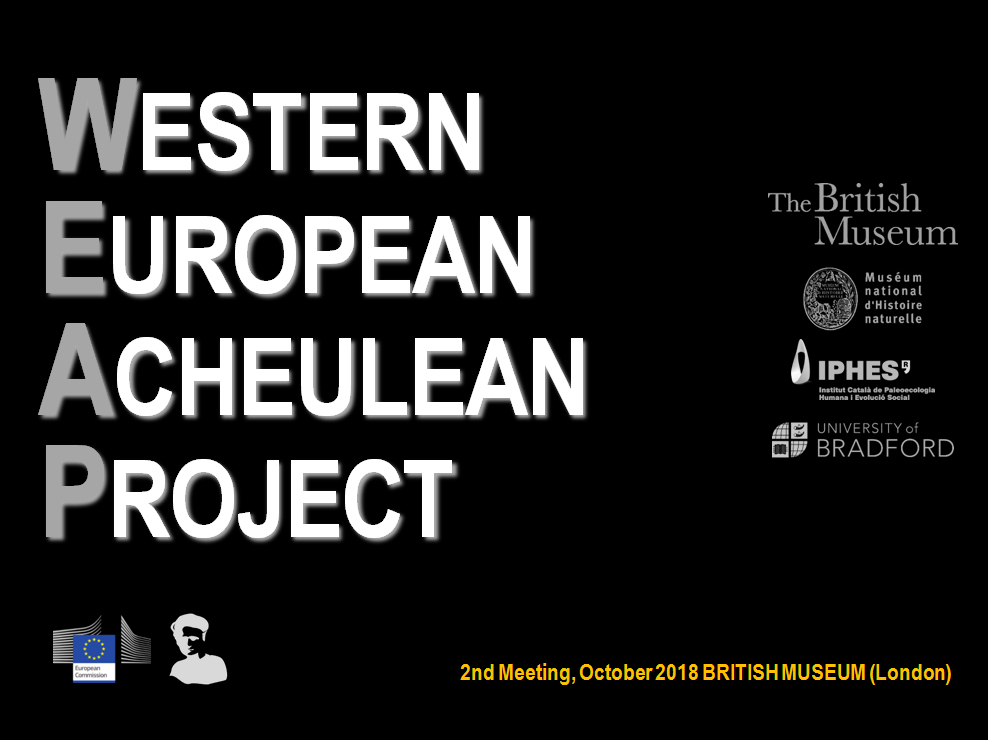

It has been a very useful session where we went over the work done during first year of the project, and we have defined the best way to face the second year. More than the 90% of the analyses were done at this time. We have got interesting preliminary results which led us to face the occupation of the Western side of Europe from more reliable positions.
In the agenda, seminars, congresses, papers, research stages overseas and new research tasks.
In conclusion, it has been defined the typical program of an active project with real future perspectives. Without any doubt, the collaboration between researchers and international institutions makes richer projects with deeper analytical roots.
Internal Workshop IPHES & URV Erasmus Mundus Research Exchange and Collaboration (EMREC): Catalonia-Israel 2018, (Tarragona, Spain) (21th-25th September 2018)
With
the participation of Gonen Sharon (THC) and Leore Grosman (HUJI)


24th EAA ANNUAL MEETING, (Barcelona) (5th-8th September 2018)


LA NOIRA (Loire Basin,
Central France) (5th July 2018)
The site of la Noira is located in the Middle Loire Basin (Centre region, France). In this area, the fossil fluvial system of the Cher River is composed of nine stepped alluvial formations deposited during the Early and Middle Pleistocene. The site of la Noira is covered by the Fougères Formation, which is one of the stepped Pleistocene fossil fluvial sheets deposited by the Cher River (1). The site of la Noira was discovered in the 1970s in a quarry. Systematic geological and geochronological studies have been applied since 2003.



Five successive strata have been defined (from bottom to top): a coarse slope deposit (stratum a), covered by two sequences of sandy alluvial layers (stratum b), then a rubble level (stratum c) and a sandy-silty soil (stratum d). The lower level (oldest) is located in stratum a, whereas upper level (younger) is located at the top of stratum c. The basal layer (stratum a) was deposited on the limestone bedrock at the beginning of a glacial stage after the river incision (1).
The age of fluvial formation was determined using the ESR method applied to optically bleached sedimentary quartz grains. The ages obtained for the Lower Level are 655 ± 55 ka and 730 ± 210 (1,2). The hominin occupation occurred between the end of river incision and the fluvial deposits and suggests that hominins were present during the beginning of the glacial stage, just before the pleniglacial phase and before interglacial fluvial deposition. This glacial/interglacial cycle can be assigned to the MIS 16/ MIS 15 cycle (3). The Upper Level has a date of 449 ± 45 ka. This stratum c had overlaid an erosive surface which truncated ice-wedges, that suggests that those artifacts were probably abandoned during a temperate phase (4).
We have included complete handaxes from both levels in WEAP: from Lower, N=33 and from Upper, N=43.
The bifaces in the lower are produced on thin millstone slabs and include both classic handaxes, bifacial tools and a cleaver. The bifacial tools are made by peripheral removals originating on the cutting edges, keeping a large cortical surface in some cases. Secondary retouch on the edges is rare. Nevertheless, we have detected the combination of hard and soft hammers. The more intensively worked handaxes present the combination of a first series of deep and invasive removals and a second series of shorter and thinner removals. Sometimes, we have detected the presence of final retouch on the tip and parts of edges.



The
upper level shows several important differences. The local millstone slabs are
combined with semi-local cretaceous flint (4). The bifaces are more intensively
worked, the pointed shapes are well defined and the use of soft hammer techniques
is more common, generating straight edges.



(1) Despriée J, Voinchet P, Tissoux He, Bahain J-J, Falguères C, Courcimault G. (2011). Lower and Middle Pleistocene human settlements recorded in fluvial deposits of the middle Loire River Basin, Centre Region, France. Quaternary Science Review 30: 1474-1485.
(2) Voinchet P, DesprieÂe J, Tissoux H, Falguères C, Bahain J-J, Gageonnet R. (2010) ESR chronology of alluvial deposits and first human settlements of the Middle Loire Basin (Region Centre, France). Quaternary Geochronology 5: 381-384.
(3) Moncel M-H, Despriée J, Voinchet P, Tissoux H, Moreno D, Bahain J-J, et al. Early evidence of Acheulean settlement in northwestern Europe-la Noira site, a 700 000 year-old occupation in the center of France. PLoS ONE 8: e75529. https://doi.org/10.1371/journal.pone.0075529
(4) Iovita, R., Tuvi-Arad, I., Moncel, M.-H., Despriée, J., Voinchet, P.,
Bahain, J.-J. (2017) High handaxe symmetry at the beginning of the
European Acheulian: The data from la Noira (France) in context. PLoS ONE 12(5): e0177063.
https://doi.org/10.1371/journal.pone.0177063
SAINT-PIERRE-LÈS-ELBEUF (Seine Valley,
France) (15th June 2018)
The site of Saint-Pierre-lès-Elbeuf is located in the Seine Valley, and was discovered through old quarrying, but there has been fieldwork since 2005 on the lower part of the sequence (1). Four loess layers are interspersed with four interglacial soils: Elbeuf I (Eemian) to Elbeuf IV. The oldest soil (Elbeuf IV) is immediately overlain by white alluvial sands with faunal and lithic remains in secondary position. It is also covered by a limestone tufa which includes faunal remains, occasional flint artefacts and an interglacial molluscan fauna with Lyrodiscus. This fauna indicates both oceanic and continental climate, together with Lusitanian (Iberian seaboard) species that have also been recorded at the nearby site of Vernon (2). This tufa has been attributed to MIS 11.
Above the tufa a loess, attributed to MIS 10, was deposited with molluscan remains, badly preserved bifaces and flake-tools associated with the banks of a river. Other Acheulian artefacts were found during the 19th and early 20th centuries, but these have been poorly documented. The recent fieldwork has investigated the white sands and tufa overlying the paleosol Elbeuf IV. One area of 45 m2 yielded in situ Acheulian artefacts and faunal remains (2), while rolled artefacts and some bones in secondary context were recovered from another area at the same level.
From
the old and new collections, two occupation phases have been identified from
below and above the tufa (3). The lower assemblage is mainly composed of large
pointed elongated bifaces with thin, well-worked tips, bifacal cores and Quina
scrapers. Bifaces from the higher assemblage are varied in size and form (from ovates
to pointed forms) with final retouch on the cutting edges. They are symmetrical
in form with thin tips and thick butts. WEAP includes a short sample of this
site. In this case, 10 handaxes has been scanned, photographed and analysed.


(1) Lautridou, J.-P., Verron, G., 1970. Paléosols et loess de Saint-Pierre-lès-Elbeuf. Bulletin l'Association Françoise pour l'étude Quaternaire 2, 145-165.
(2) Cliquet, D., Lautridou, J.P., Antoine, P., Lamotte, A., Leroyer, M., Limondin-Lozouet, N., Mercier, N., 2009. La séquence loessique de Saint-Pierre-lès-Elbeuf (Normandie, France): nouvelles données archéologiques, géochronologiques et paléontologiques. Quaternaire 20 (3), 321-343.
(3) Moncel, M.H., Ashton, N., Lamotte, A., Tuffreau, A., Cliquet, D., Despriée, J., 2015. The Early Acheulian of north-western Europe. Journal of Anthropological Archaeology 40: 302-331.
XVIII UISPP WORLD CONGRESS, (Paris, France) (4th-9th June 2018)







MENEZ DREGAN I, (Finistère, Brittanny, France) (29th May 2018)
The Lower Palaeolithic site of Menez Dregan is located on the Armorican Massif. It is an ancient marine cave where the roof has been progressively partially protecting the archaeological living floors. It has been under the excavation since 1991. Menez Dregan is one of the few sites in Europe with a long stratigraphical sequence, which displays and alternating sequence of levels of human occupation and marine deposits between ca. 465 and 113ky (1).



In a regional scale, the Lower Palaeolithic in the Armorican Massif consist of two different groups: Colombanian industries and Acheulean sensu stricto (2).
The Colombanian was first defined after the discoveries at Saint-Colomban (Carnac, Brittany) by Monnier in the late 1980s (2). All the Colombanian sites (e.g. la Croix Audran, the island of Groix, Primlelin, Le Bois-de-la-Chaize) are located in the current shoreline, their deposits sheltered in corridors of marine erosion or in collapsed marine caves. These industries are characterized by the predominance of cobble tools among heavy-duty tools, retouched light-duty tools on flake -blanks comprising mostly notches and denticulates. The Levallois method is totally absent, handaxes are very rare and there are few scrapers.
In the past years, Menez Dregan I has been attributed to the Colombanian group (Monier, 1996). Nevertheless, according to the last findings, the lithic industries always include some Acheulean components (3), such as handaxes and cleavers. It has been proposed that the Colombanian is similar to the Acheulean and the technological differences are only the result of the local adaptation to the raw materials.
The localization of
this site (Finistère), its long stratigraphical sequence and the re-interpretation
of its industry, make that this site one of the most interesting in the Western
side of Europe. So, the whole set of Large tools from Levels 8 and 7 (MIS 11-MIS
10) has been analysed and scanned (N=20). This large tools include handaxes and
cleavers, made on flakes of quartzite, sandstone, microgranite and quars. The
cleavers present a very marginal shaping and wide transverse cutting edges; and
the handaxes, keeping an important cortical part, present a shaping with very
big and invasive scars, and sometimes a second removal series mainly localized
on only one edge.


(1) Mercier, N., Froget, L., Miallier, D., Pilleyre, T., Sanzelle, S., Tribolo, C., 2004. Nouvelles données chronologiques pour le site de Menez-Dregan 1 (Bretagne): l'apport de la thermoluminescence. Quaternaire 15 (3), 253e261.
(2) Monnier, J.-L., 1996. Acheuléen et industries archaïques dans le Nord-Ouest de la France. In: Tuffreau, A. (Ed.), L'Acheuléen dans l'Ouest de l'Europe. Actes du colloque de Saint-Riquier, 6-10 juin 1989, 4. Publications du CERP, Lille, pp. 145e154.
(3) Ravon, A.-L., Gaillard, C., Monnier, J.-L., 2016. Menez-Dregan (Plouhinec, far western Europe): The lithic industry from Layer 7 and its Acheulean components. Quaternary International 411: 132-143.
Project Menez Dregan information:
Facebook: Centre d'interprétation de
Menez Dregan
Twitter: @MenezDregan
SWANSCOMBE, UK (8th May 2018)
The sequence at Swanscombe has been known since the early 20th century. The Thames terrace deposits consist of the Lower Gravel, Lower Loam (Stage I), Middle Gravels (Stage II), and a series of overlying sands, loams and gravels (Stage III). The fluvial sediments (Stages I and II) are attributed to the Hoxnian interglacial (MIS 11c) and associated with a fully temperate climate. Most of the artefact assemblages are abraded and probably in secondary context.
The Stage I deposits contain non-biface assemblages (1) and date to the first half of the interglacial, while the biface assemblages from the Stage II deposits date to the second part of the interglacial (2).
The Stage II deposits are divided into the Lower Middle Gravels and the Upper Middle Gravels. In this case, we have focused on the excavations of the Upper Middle Gravels by Wymer in the 1950s, which provided a large series of bifaces associated with the Swanscombe skull (3). The assemblage is in secondary context, but was probably derived from the nearby floodplain of the river, using nearby flint gravels as thesource for raw material (4). We have analyzed and scanned 50 handaxes. These tools are characterized by sub-triangular shapes, with elongated and think forms. They present large removals, retaining cortex and with little retouch. The exception are the tips, where is concentrated the most part of the secondary retouch.
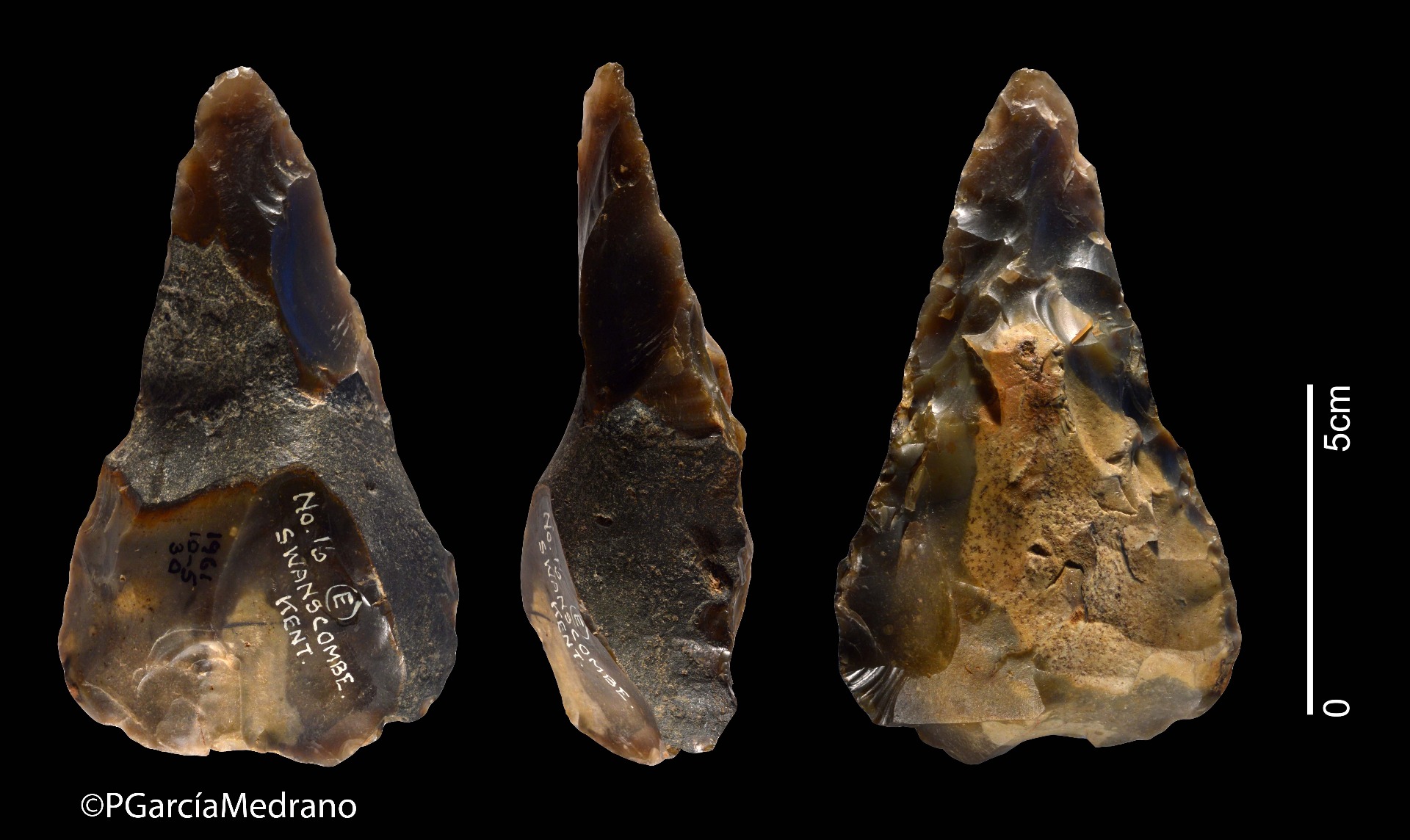

(1) Conway, B., McNabb, J., Ashton, N.M. (Eds.), 1996. Excavations at Swanscombe 1968-1972. British Museum Occasional Paper 94, London.
(2) Smith, G.M., 2013. Taphonomic resolution and hominin subsistence behaviour in the Lower Palaeolithic: differing data scales and interpretive frameworks at Boxgrove and Swanscombe (UK). Journal of Archaeological Science 40 (10), 3754-3767.
(3) Ovey, C.D. (Ed.), 1964. The Swanscombe Skull. A Survey of Research on a Pleistocene Site. Royal Anthropological Institute Occasional Paper No. 20. Royal Anthropological Institute of Great Britain and Ireland, London.
(4)
Moncel, M.H., Ashton, N. Lamotte,
A.,Tuffreau, A.,Cliquet, D.,Despriée, J. (2015). The Early Acheulian of
north-western Europe. Journal of
Anthropological Archaeology 40, 302-331.
ELVEDEN, Suffolk, UK (19th April 2018)
This site is located on the Breckland area, as well as Brandon Fields, also included in WEAP.
The first pit was open in the 1890s until 1900, when flint artefacts, particularly handaxes were collected. The second phase was in 1918, after which the pit was abandoned. The first formal excavation at the site was in 1937 (1). Paterson recovered more than 600 artefacts and his interpretation formed part of his framework the BrecklandPleistocene sequence (2). The most recent project was initiated in 1995 until 1999 by the British Museum. Five main archaeological areas were examined, of which two provided the major part of the lithic assemblage (I and III). As part of the geological work, ten sections and 9 pits were dug and series of boreholes were completed. The stratigraphic sequence consists of Chalk andAnglian (MIS 12) till at the base, into which a basin was cut that infilled with fine-grained fluvial and lacustrine sediments. The palynology indicates the first half of an interglacial, while amino acid ratios suggest a Hoxnian age. The site is therefore correlated with MIS11c (c.400ka) (3).
The archaeological areas were located on the
edges of the basin and knapping used the coarse gravel that had formed as a lag
in these areas Biface manufacture was the main activity at the site, together
with a minor production of simple flake tools, flakes and cores. So, at Elvedenthe
refitting and analysis of the debitage
shows the complete operational chain of shaping. In the context of WEAP, we
have analysed, photographed and scanned 40 pieces: 30 handaxes from the old excavations
and another 10 pieces (2 handaxes, 3 fragments and 5 rough-outs) from the
recent fieldwork. These tools are made on flint, of really good quality. In
many cases these tools are made on flakes but more frequent we cannot determine
the type of base due to the intensity of thinning work. They are well-shaped
tools, with final retouch modifying the edges and tips. There is a small presence
of cortex and many of the forms present S-twist profiles.


(1) Paterson, T.T. and Fagg, B.E.B., 1940. Studies on the Palaeolithic succession in England. No II. The Upper Brecklandian Acheulean (Elveden). Proceedings of the Prehistoric Society 6, 1-29.
(2) McNabb, J., 1998. The history of investigations at the East Farm Pit, Barnham. In N. Ashton, S. Lewis and S. Parfitt (Eds.) Excavations at the Lower Palaeolithic Site of Barnham St. Gregory, Suffolk, 1989-1994. London, UK. Occasional Papers of the British Museum 125, 5-12.
(3) Ashton, N., Lewis, S., Parfitt, S., Candy,
I., Keen, D., Kemp, R., Penkman, K., Thomas, G., Whittaker, J., White, M.,
2005. Excavations at the Lower Palaeolithic site at Elveden, Suffolk, UK. Proceedings of the Prehistoric Society
71, 1-61.
BOXGROVE, UK (3rd April 2018)
Boxgrove - c.500ka - is one of the most informative sites at which to analyze shaping strategies and handaxe morphological variability in the European Middle Pleistocene, because of the large number of finished handaxes, and the presence of complete operational chains.



The geology at the site of Boxgrove consists of a
sequence of Middle Pleistocene marine, freshwater and terrestrial sediments
exposed in the former Eartham Quarry, Boxgrove, West Sussex, UK.
Archaeology occurs in all the main sedimentary units in the sequence but is
preserved in situ and in the greatest concentration within an intertidal and
regressional deposit, the Slindon Silt Member (Units 4a-c). The units
comprising this member were formed within a semi-enclosed marine embayment at the
onset of marine regression (1)(2). Artifact concentrations occur on the surface
of these intertidal silts in a soil horizon - Unit 4c - and in rare freshwater
lake and lake overflow deposits that derive from groundwater emanating from the
base of Clalk cliff - Units 3c, 3/4, 4u, 4 - (3), these sediments are referred
to as the waterhole deposits and are a temporal correlative of the soil
horizon. These fine grained sediments preserve a series of palaeoland surfaces
with abundant faunal and lithic remains, that have been dated by correlative
mammalian biostratigraphy to the last temperate stage of the Cromerian Complex,
Marine Isotope Stage (MIS) 13, (524-478 ka). The combination of cold stage
sediments overlying the temperate sediments and the presence of transitional
mammal faunas, indicate that the archaeology at Boxgrove was deposited during
the terminal part of the interglacial into the ensuing Anglian Cold Stage (MIS
12) (4)(2).

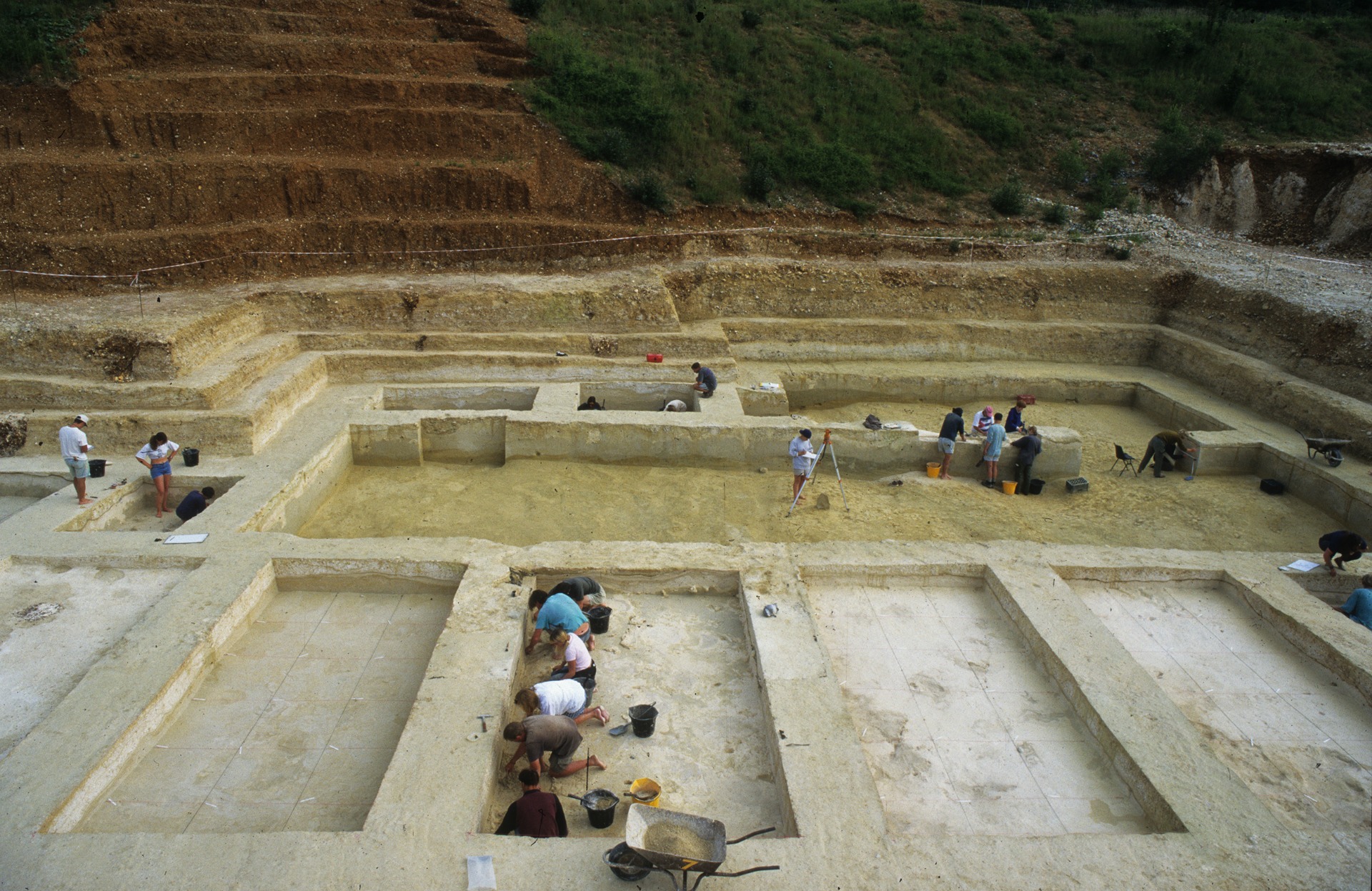

The Boxgrove lithic collection is exceptional in terms of its preservation, due to the nature of its burial and its subsequent taphonomic history, and because of the great quantity of large tools recovered, mainly handaxes (more than 350, Quarry 1B). This assemblage is one of the best examples of Acheulean technology in Europe. Typologically, refined ovate handaxes predominate with regular and sharp edges (4). Previous analyses of the debitage indicated that soft hammers were used at the site (5), and 41 bone and three antler hammers were recovered from the Q1/B excavations (4)(6). The combination of the high density of knapping activity, the complete reduction sequences, the technological refinement of the handaxes, and their exceptional preservation, provides a good opportunity to analyze the shaping strategies employed in the production of Acheulean large cutting tools.
In the context of WEAP, 50 handaxes from the
Quarry 1B, Unit 4 have been analyzed. These are the result of long sequences of
flint knapping. A first shaping phase is developed using mainly hard percussors,
and then a frequently long phase using soft ones. The intensity of the thinning
works and the tranchett removals on
the tip characterize this assemblage.


TRAINING LAB - ABM - AGENT - BASED MODELLING, (Frankfurt) (14th-17th March 2018)
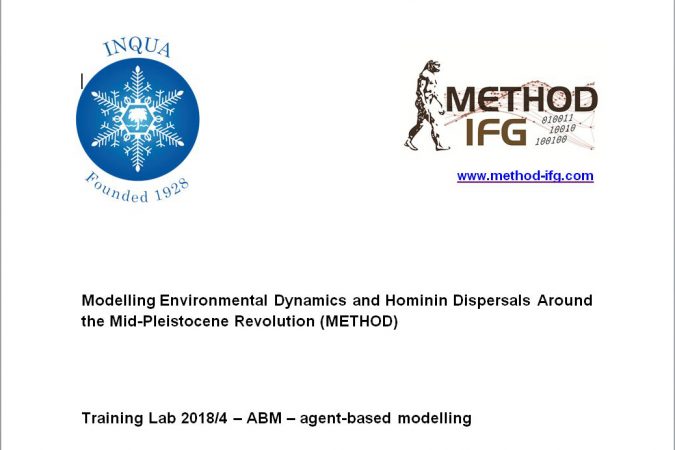
As part of the International Focus Group
"Modelling Environmental dynamics and hominin dispersals around the
Mid-Pleistocene revolution (METHOD)"
(www.method-ifg.com), WEAP has been present at the Training Lab on Agent-based Modelling, celebrated at Senckenberg Institute, Frankfurt am Main,
Germany.
Agent-based models are powerful tools for testing predictions and for comparing diverse hypotheses on dispersal events.
The first part of his Training lab has been focused on the execution of NETLOGO (the software used to generate Agent-based models): how it works, how to generate models, how to include the information and what king of information is needed to improve the models. Based on the technological similarities and differences between the different sites and regions of the Western side of Europe, WEAP will intend to define possible routes for the Middle Pleistocene occupation of this territory. So, this Training Lab has been very useful to this project.
In addition, we have been checking the progress of the "Middle Pleistocene Revolution Hominin Dispersal Agent-based Modelling", and discussing about how to include the archaeological data in the current models in order to validate them and to test our archaeological hypothesis. I'm looking forward to see how the work progresses!!






Thanks to the organizing committee: Christine Hertler (ROCEEH, Germany), Ericson Hölzchen (ROCEEH, Germany), Jesús Rodríguez (CENIEH, Spain), Ana Mateos (CENIEH, Spain)
The next meeting will be held at the CENIEH, Burgos, Spain. November 2018...
BRANDON FIELDS, UK (12th February 2018)
Brandon Fields is one of the sites located in the Breckland, one of the most important areas in Britain for understanding the changing nature of human occupation in north-west Europe (1). From 2016 the Breckland Palaeolithic Project (2), funded by the Leverthulme Trust, has been examining how human populations and their technology and material culture adapted to a developing landscape within a single region through time.



The extinct
Bytham River flowed from the West Midlands, through East Anglia and into the
North Sea, and deposited quartz and quartzite-rich gravels, which now survive
only on the sides and tops of the low-lying hills, and organized in a series of
river terraces. This river was destroyed by the Anglian Glaciation, 450Ka.
The first terrace includes: Warren Hill and the lower of the two gravel deposits at Maidscross Hill. Sediments from both sequences have been recently dated by ESR in 550Ka, which lends some support to a pre-Anglian age for these sediments.
Brandon Fields is located on the second terrace of the Bythan River, together with the higher gravel at Maidscross Hill and at Rampart Field. The age of this terrace is unknown but probably a glacial-interglacial cycle earlier than the first terrace - around 600Ka (1). According to Moncel and colleagues (3), Brandon Fields could represent the first presence of Acheulean handaxe technology in Britain.

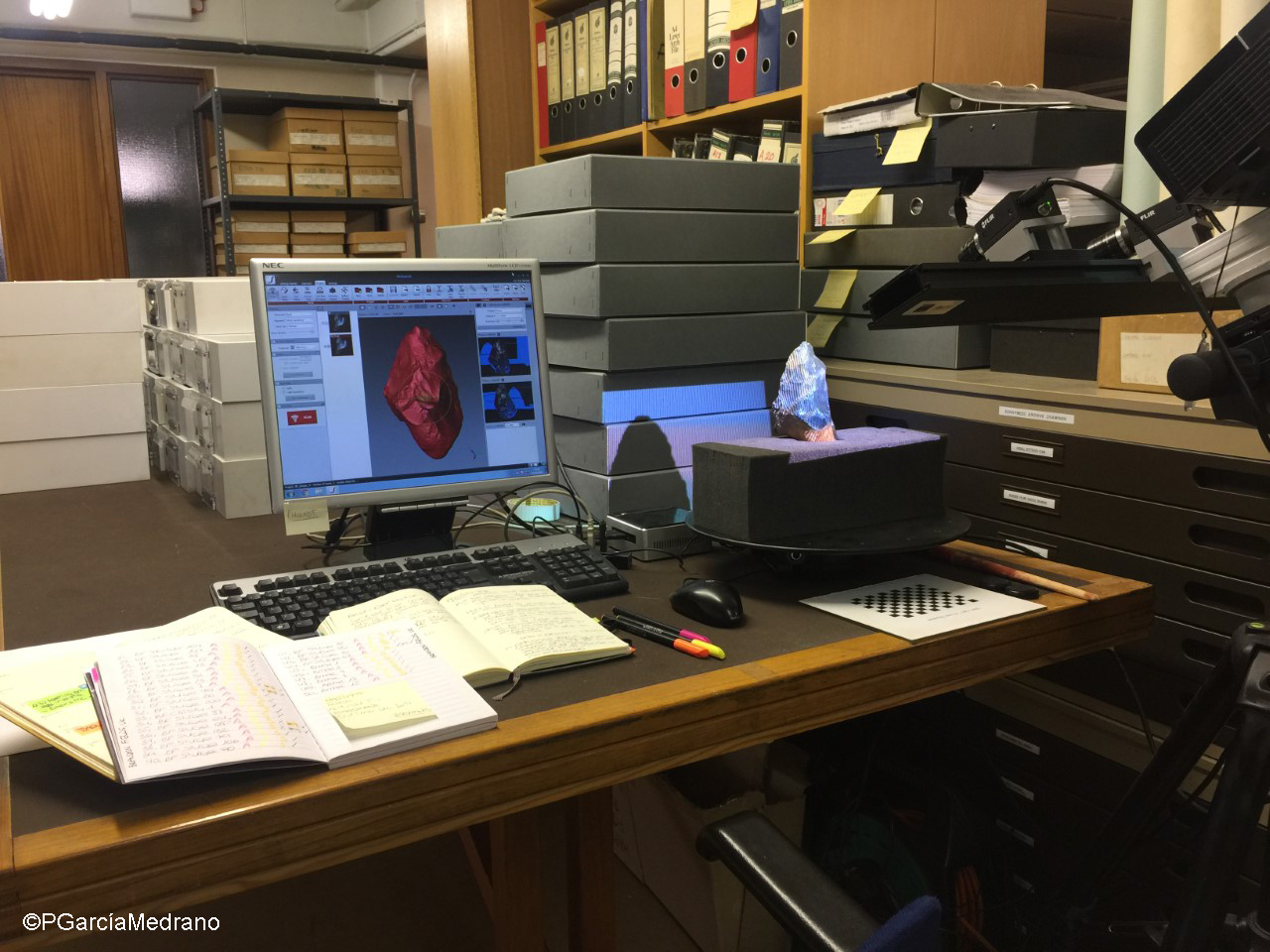
Brandon Fields has been the first assemblage studied for WEAP. We have analysed and scanned 50 handaxes. The first thing to consider is the use of several varieties of flint, most of them of a very high quality, very suitable for the knapping. The handaxes are made on both small, cortical pebbles, and non-cortical flakes. The cortex, if present, is located from the bottom to the midpoint of the artefacts. In general terms, this assemblage is characterized by the presence of crude and thick tools, with a clear tendency to pointed shapes. In spite of that, there is also a high quantity of them with secondary retouch, localized on part of one lateral edge;others havebadly developedtranchetremovals; while some pieces have "final retouch", with long, thin removals which do not modify the edge of the tools but are very invasive acrosstheir surface.


(1) Davis, R.J., Lewis, S.G., Ashton, N.M., Parfitt, S.A., Hatch, M.T.,
Hoare, P.G. (2017) The early Palaeolithic archaeology of the Breckland: current
understanding and directions for future research. The Journal of Breckland Studies, 28-44.
(2) Breckland Palaeolithic Project: https://www.researchgate.net/project/Breckland-Palaeolithic-Project
(3) Moncel,
M.H., Ashton, N., Lamotte, A., Tuffeau, A., Cliquet, D., Despriée, J. (2015) The
Early Acheulian of north-western Europe. Journal
of Anthropological Archaeology, 40: 302-331.
VISIT TO UNIVERSITY OF BRADFORD, Achaeological Sciences (22nd-23rd November 2017)
The current debate about the Acheulean is focused on determining the origin of the handaxe morphological variability. The raw material, the reduction intensity and cultural and functional hypotheses have been proposed as the determining factors in their variability. To characterize the morphology of tools, WEAP has two main approaches: 1) to take a good set of measurements for each instrument and 2) to analyze them, applying the Geometric Morphometrics' methodology, creating a tool profile applying a multivariate analysis.
Each one of these analysis will be based on 3D models of more than 400 tools. This approach will be developed under the supervision of Dr Evans (University of Bradford). He and colleagues have developed a specific interdisciplinary research protocol, blending cultural archaeology with cutting edge science. The 3D scanning will be made using a laser scan (DLP projector) and the software Flexscan (LMI technologies). In fact, The Fragmented Heritage Project has transferred a laser scan to the British Museum until the end of WEAP.
The 3D models will let us not only to explore the morphological variability of tools but also to objectify the analytical process, and make accessible the materials to anyplace in the world. So, this tool will be very useful in the near future.
I was also invited to give a Seminar at the Archaeological Science Department. I introduced WEAP, the Marie Curie experience and my personal research line. It was a nice opportunity for meeting very interesting people, other young researchers with very promising projects.
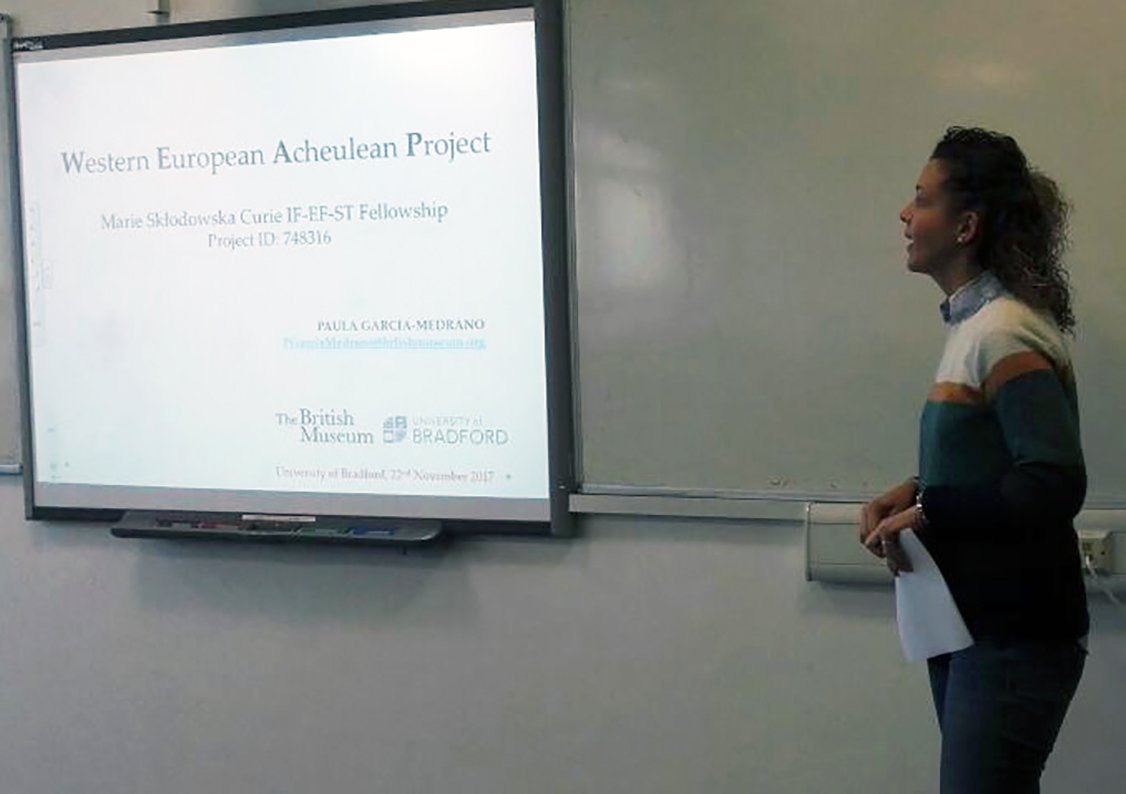


V INTERNATIONAL CONGRESS OF EXPERIMENTAL ARCHAEOLOGY, (Tarragona) (25th-27th October 2017)
WEAP was presented at the V International Congress of Experimental Archaeology.
Paula García-Medrano was part of the organizational committee and presented a
communication about The quartzite cleavers
from Atapuerca (Burgos, Spain): the standardization of shape, where it has
been explored in whole sense of the cleaver tool-type, from several points of
view: technological, morphological and functional.


THE AGREEMENT OF A COMMON METHODODLOGY, 1st Meeting (19th-20th October 2017)
WEAP will be the first project to use different systems of Middle Pleistocene lithic analysis integrated in a common approach, selecting the most significant technological features from the main traditions in lithic analysis (typological, technological, morphometrical and sequential). Then, the results will be compared, from the same perspective. WEAP's major advantage is that it will be generated through proactive discussion with some of the main lithic researchers in UK, France and Spain and therefore likely to be extended beyond the life of the project, becoming relevant to other Lower Palaeolithic researchers.
The
First Meeting was celebrated at the British Museum at the end of October, during
two main sessions. The first one, was devoted to the agreement of the
terminological corpus and the main technological features to be used along the
project. This common method was decided with three of the main specialists on these European Middle Pleistocene
industries: Dr. Nick Ashton (Project Supervisor, UK), Dr. Marie-Hélène Moncel
(France) and Dr. Andreu Ollé (Spain).



The second day was
mainly devoted to introduce the agreed methodology to a group of researchers,
specialised in Palaeolithic contexts and lithic technologies: John McNabb,
Matthew Pope, Rob Davis, Adrian Evans, Beccy Scott, Andrew Shaw, between
others. Besides, John McNabb gave a talk
about the handaxe symmetry and its significance, main topic of his last
article.



